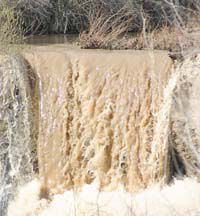| Runoff water pours over a drop in the Price River during the runoff season in April of 2005. That year it appeared a drought that was seven years long might be over. But low precipitation this past winter shows the dry spell might be rearing its head once again. |
For anyone who has been in the mountains this winter, it is an evident fact. There has not been as much snow as in the last two years.
And in fact this winter may have been the worst in many, many years for moisture.
Last fall the rains came and the ground was well soaked almost everywhere in the Price watershed. But a winter with precipitation well below normal standards has brought the county to the brink of something most people thought ended last year.
A drought.
Snowpacks this past winter were often not over 50 percent of normal at any one time, and often below that. In fact, while most of the rest of the state was experiencing a low snow year, the area around Carbon County was one of the worst for accumulated snow in Utah.
That fact, doubled with a report that recently was released by the state of Utah called Drought in Utah; Learning from the Past, Preparing for the Future, appears to point to the fact that these water troubles will not be short lived.
According to the report, the droughts that the state has experienced in the last 100 years have been short compared to the droughts that have taken place over the last 2000 years in the area. On average droughts throughout the 20th century averaged about seven years in length, while the tree ring record shows droughts more on the average of 11 years.
While Carbon County residents have been used to facing droughts over the years, these longer droughts could tax the collection and storage system that has been set up in the last 125 years much greater than anything before it.
At biggest risk is the growth of the area. In 1950 the population of the county was around 40,000, and now it hovers around 20,000. In those days, however, a large chunk of the population lived in various canyons and outposts mining coal. Much of their water was supplied by mines and small water works. Today the population is concentrated in the central part of the county and it relies on snow melt that fills Scofield Reservoir. The system to supply water is centered around that.
Much of the water is used for agriculture. Growth in the county, both in population and the kinds of industries that could come here to provide more jobs would all require water.
The report addresses several important issues related to drought. It: (1) emphasizes the significance of drought and its impacts to society from a historical perspective and how projected growth can potentially make Utah more vulnerable; (2) warns about the likelihood of more severe and longer-term droughts in the future based on reconstructed climate and proxy records as well as climate change; (3) explores various strategies to mitigate, prepare for and respond to future drought events; and (4) makes recommendations for future action at the state and local level.
For now all water planners in eastern Utah can hope for is a wet May and a summer in which the temperatures don’t go too high.
And then for a heavy snowfall winter next season.

